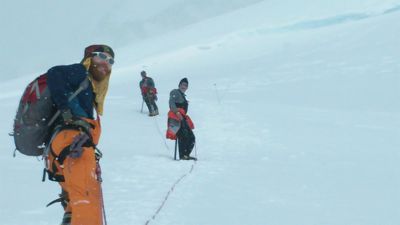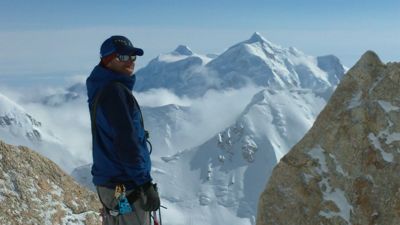Ken has departed us and returned to Maine. His time with us in Denali National Park was a fantastic experience both for Ken and the rest of us. For Ken and I the highlight was certainly reaching the satellite peak on the West Buttress route at over 13,000 feet above sea level. What an experience to bring my grade school science teacher to such an amazing place! Several days have passed since Ken departed and much has happened so I will try to bring you all up to speed. We have all acclimatized for working at high elevation and are officially into our science portion of the project with a goal of extracting an ice core that covers over 1000 years of climate record from a place we call the Mount Hunter Ice DivideAn ice divide is analogous to a watershed divide. An ice sheet divide separates opposing flow directions of ice on an ice sheet. located at 13,000’ above sea level.
Ken participated in a necessary and critical part of our trip this year. During the first couple of weeks in the mountains our goal was to climb from 7,600 to 14,200 feet above sea level to help our bodies acclimatize to life at a high elevation where we will drill the ice core. High elevations are generally drier, colder, and windier, and there is less atmospheric pressure and higher UV exposure relative to lower elevations. There is literally less air due to atmospheric thinning and decrease in atmospheric density. It is harder for a body to get the necessary oxygen to stay healthy, because with less air there is less available oxygen. I think it’s SUPER important for people to understand WHY we spent the first couple of weeks during this field season doing what many people in the world would consider “PLAYING” or mountaineering as a basic sport. This will likely be the MOST serious blog I ever write but hopefully everyone finds it interesting. I’m obviously not a doctor but the general details below are some of what we know about altitude illness and the general consensus about how our bodies react to high elevations. Generally speaking we “acclimatize” to high elevation by making healthy decisions and by slowly allowing physical changes in our body that enable healthy living at elevation.

We consciously combat the cold, dry, and windy conditions at high elevations by:
- Drinking more water to stay hydrated (we breathe out more water in drier conditions)
- Wearing more clothes to stay warm
- Using more sunscreen to protect our skin from sun burns
Air pressure is less at higher elevations relative to sea level because there is less of Earth’s atmosphere pushing down from above. In other words, as we gain in elevation the atmosphere is less dense meaning that there is less oxygen per unit volume then at sea level. The human body needs a certain amount of oxygen to survive. It responds physically to less oxygen at higher elevation, unconsciously, through more rapid breathing (more breaths = more oxygen intake) and more red blood cell production. Red blood cells carry oxygen so more red blood cells in the body results in greater oxygen capacity for each breath. Of course, the down side of breathing faster is that we expel more water with each breath which means we must drink more water to replace that which is lost. A normal person at sea level may drink 2 quarts of water per day whereas we generally average 3-4 quarts per day at 13000-14000’ above sea level.
If we consciously make appropriate decisions and allow our bodies to acclimatize naturally at higher elevations, generally we can avoid altitude illness. However, if we don’t pay attention to our bodies responses to altitude, we can become very sick. Altitude illness occurs in several forms with different levels of severity. However, I personally like to think of altitude illness as a “continuum” whereby if we ignore early signs or symptoms of altitude illness, that illness will progressively get worse. Early stages of altitude illness known as acute mountain sickness have common signs such as headache, nausea, vomiting, shortness of breath, and dizziness, or changes in mood (i.e. a happy person changes to a sad quiet, or grumpy person!) These signs may be caused by such issues as dehydration or lack of oxygen in the blood due to over exertion and not being able to bring in enough oxygen while breathing at higher elevations. Obvious fixes to these issues include drinking more water, exerting less energy, and importantly, moving to a lower elevation if the early signs appear to be getting worse.
Acute mountain sickness can eventually be deadly if a person continues to ignore the signs and symptoms, although it is not the only altitude illness that can kill. A couple other altitude illnesses are High Altitude Cerebral Edema (HACE) and High Altitude Pulmonary Edema (HAPE). HACE. These are a continuum of symptoms from acute mountain sickness whereby fluid (water) swells in the body due to lower pressures at higher elevations. That fluid is excreted or leaks into the head surrounding the brain. The skull is basically a fixed volume so if we start filling that space within the skull with fluid, then more pressure is placed on the brain. Increased brain pressure results in similar signs to people with head injuries such as headaches, nausea, vomiting, dizziness, blindness, loss of motor skills, and eventually unconsciousness or death due to brain tissue damage. SO…. You can see that problems associated with altitude are very serious considerations for our group! As a team we approached this acclimatization climb with two important rules:
If any signs of altitude illness appeared within ANY OF US… we needed to fix the issue immediately. We Err’ on the side of caution. If someone presented any signs or symptoms that COULD be altitude illness OR have another cause, we would assume it was altitude related and treat accordingly.
Fortunately, we took a slow steady pace from base camp up to 14,000 feet. The most anyone experienced was a headache on one day climbing from 11,200 to 14,200 feet and back to 11,200 feet. However, the headaches disappeared in the afternoon at 11,200 feet once everyone ate and drank a bunch of water… this was a good sign!

We are now ALL at the ice core drill site and we all fortunately feel great which means that our acclimatization plan was successful. We have some back up plans which include a potential descent to 10,500 above sea level on a known route I have travelled from the drill site, as well as some prescription medications that treat altitude illness if anyone seems to present signs of it. BUT, we all continue to hydrate, eat well, sleep much, try not to over exert ourselves, and so far everyone is very happy. We all say “SLOW AND STEADY” which I think is the mantra for our trip. If we stick to this game plan, it should continue to be a good season!


Comments